Incense of Music Nr. 53 - Nebbia, Parkins
Incense of Music Nr. 53
Ein multisensorisches Konzert- Freitag, 9. Februar 2023, 20 Uhr
Incense of Music ist zurück mit einem äußerst experimentellen Konzert eines Trios mit Camila Nebbia, Andrea Parkins und einem Überraschungsgast.
Camila Nebbia: Tenor Saxophon
Knaackstr. 97, 10435 Berlin
Düfte appellieren an den am meisten vernachlässigten Sinn der Neuzeit, den Geruchssinn. Sie beeinflussen den menschlichen Geist und eröffnen neue Erfahrungen. Diese Eigenschaften legen nahe, diese alte Kunst, die in jeder Kultur vorhanden ist, mit Musik in einem synästhetischen Projekt zwischen Zuhören und Riechen zu kombinieren.
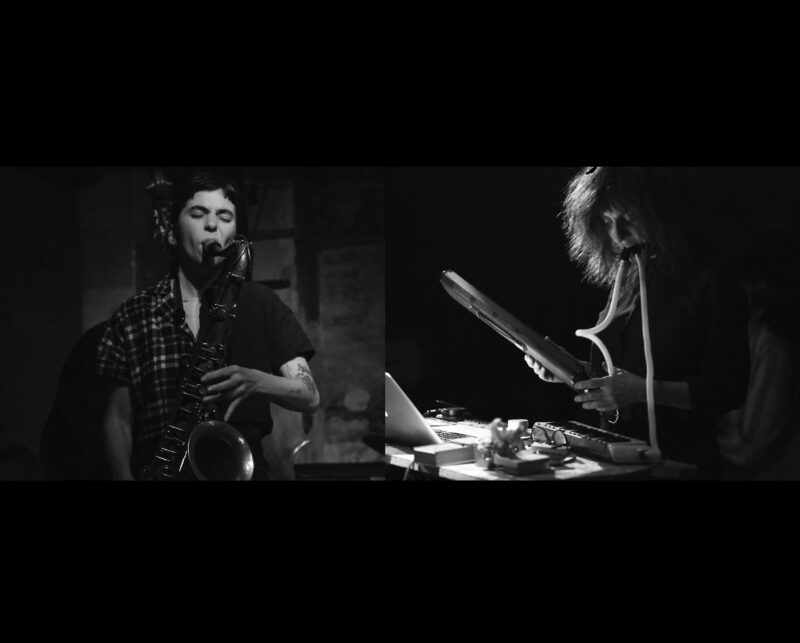
Andrea Parkins
Born: Pittsburgh, USA Lives: Berlin www.andreaparkins.com
Andrea Parkins is an electroacoustic musician, composer, and sound artist who engages with interactive electronics as compositional/performative process. Working with an array of sonic materials – electronically processed accordion, custom-built software, amplified objects, and electronic feedback – her performances and installations explore connections and slippages between the body, materiality, sound, site, and space.
Parkins’ projects include multi-channel sound performances and intermedia installations, electroacoustic solo and ensemble compositions; and sound for contemporary dance, experimental film and intermedia performance. She performs as a solo artist, and has collaborated with artists such as Ute Wassermann, Magda Mayas, George E. Lewis, Nels Cline, The Necks, choreographer Vera Mantero, and filmmaker Abigail Child, among others. Her performances and installations have been presented at venues such as the Whitney Museum of American Art, Café Oto, The Kitchen, Experimental Intermedia (NYC), Kunsthalle Basel, and Musée d’Art Moderne et Contemporain, Strasbourg. Festival appearances have included NEXT/Bratislava, Cyberfest/St. Petersburg, All Ears/Oslo, Jazz im Augusto/Lisbon, Music Unlimited/Wels, and many more.
Parkins’ recent projects include The Stray II, a site-responsive 8-channel spatial audio and visual installation that was featured at Momentum 12/The Nordic Biennale at Galleri F15 in Moss, Norway; her intermedia installation, Sonic Spaces for the Stray, presented in 2021 at ROM for kunst og arkitektur in Oslo; and her performance/installation, Two Rooms, Variation 1, for 40 loudspeakers and Solo Performer, premiered in 2016 at Akousma Festival in Montreal.
Andrea Parkins has been an invited resident artist at Rauschenberg Residency in Captiva, Florida; Elektronmusikstudion (EMS), Stockholm; Harvestworks Digital Media Arts Center (NYC); and by Frei und Hanseastadt Hamburg Kulturbehoerde. Her recordings are published by Important Records, Infrequent Seams, Confront Recordings, Atavistic, Henceforth Records and Creative Sources; and she can be heard as a contributor on numerous other labels. In 2022-2023, she is a fellow of the Berliner Förderprogramm Künstlerische Forschung / Berlin Artistic Research Grant Programme.
Recent Press:
“Sounding Objects: Andrea Parkins Interviewed by Lea Bertucci: Expanding Notions of Composition” Bomb Magazine (6 May 2022). https://bombmagazine.org/articles/andrea- parkins-interviewed/
“11+3 Interview with Andrea Parkins.” Digital in Berlin (August 2020,) https://www.digitalinberlin.de/andrea-parkins
Camila Nebbia
Camila Nebbia is a saxophone player, composer, improviser, visual artist, curator and educator debasing hierarchical systems by exploring counterpoints of migrational longing through multiple, but minimally separated, mediums. From Buenos Aires, Argentina, based in Berlin, Germany, the multidisciplinary artist layers her practice through the creation and destruction of archival memory.
Has released as a band leader and solo performer “A veces la luz de lo que existe resplandece solamente a la distancia” (Kuai 2017), “De este lado” (Club del disco 2019), Aura (ears&eyes records 2020),“Corre el río de la memoria” (ramble records 2021) and “Presencias” (Sound Holes 2021) “Una ofrenda a la ausencia” (Relative Pitch Records 2023).
Played and recorded with many artists of the international scene such as Valentin Garvie, El devenir del río, Burka, Paula Shocron, Barbara Togander, Patrick Shiroishi, Paul Pignon, Vinnie Sperrazza, Katt Hernandez, Kenneth Jimenez, Lesley Mok, Violeta García, Axel Filip, Susana Santos Silva, Tom Rainey, Elsa Bergman, l’ Arfi collective of Lyon, Joanna Mattrey, Micheal Formaneck, Vincent Dromowski’s Flow regulator, Sofia Borges, John Hughes, among others.
Co-creator and curator of the collective interdisciplinary group and improvised music series “La Jaula se ha vuelto pájaro y se ha volado”, the interdisciplinary festival “Guillotina Fest'' and creator and curator of the streaming concert series called “The warmth of proximity” and “A door in the mountain”. Runs the concert series and independent label “Disfigured Rivers” based in Berlin.
Participated of many festivals around the world such as Winter Jazz Fest NYC co-presented with M3 (U.S), Buenos Aires Jazz Festival (ARG), Lima Jazz Festival (PE), Diskurs Festival (DE), Ultima Oslo (NO), Saalfelden Jazz Festival (AT), among others, and has assisted to several residencies such as, ART OMI (NYC), SIM (NYC) Jazz & Creative Music dictated by Tyshawn Sorey and Vijay Iyer (CA), Konvent Zero (ES) UNCOOL (CH), Ensemble Evolution (US), CirkusVranen (SE), CCK with Tim Berne, Marilyn Crispell & Ben Goldberg (AR), among others.
Studied classical saxophone at the Conservatory "Astor Piazzolla", jazz at the "Manuel de Falla" Conservatory, Film Direction at the Universidad Del Cine, and the master degree program “CoPeCo Contemporary Performance and Composition at Estonian Academy of Music and Theatre in Estonia, Royal College of Music in Stockholm in Sweden, National Superior Conservatory of Music Dance of Lyon in France and Hamburg University of Music and Theatre in Germany. Was part of the second cohort of Mutual Mentorship for Musicians M3 created by Jen Shyu & Sara Serpa 2021, and was a curatorial fellow at the Experimental Sound Studio of Chicago 2022. Camila Nebbia is endorsed by D’Addario Woodwinds.
Abelmoschus
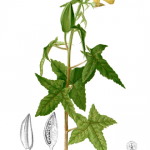 Der Bisameibisch (Abelmoschus) ist eine Pflanzengattung, die zur Familie der Malvengewächse (Malvaceae) gehört. Die Arten sind in subtropischen und tropischen Gebieten des südlichen und südöstlichen Asiens und im nördlichen Australien beheimatet.
Der Bisameibisch (Abelmoschus) ist eine Pflanzengattung, die zur Familie der Malvengewächse (Malvaceae) gehört. Die Arten sind in subtropischen und tropischen Gebieten des südlichen und südöstlichen Asiens und im nördlichen Australien beheimatet.
Abies nordmanniana
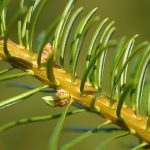 Die Nordmann-Tanne (Abies nordmanniana), standardsprachlich Nordmanntanne, auch Nordmanns Tanne und Kaukasus-Tanne genannt, ist eine Pflanzenart aus der Gattung Tannen (Abies) in der Familie der Kieferngewächse (Pinaceae). Die Nordmanntanne ist heute die meistgenutzte Baumart als Weihnachtsbaum. Read more
Die Nordmann-Tanne (Abies nordmanniana), standardsprachlich Nordmanntanne, auch Nordmanns Tanne und Kaukasus-Tanne genannt, ist eine Pflanzenart aus der Gattung Tannen (Abies) in der Familie der Kieferngewächse (Pinaceae). Die Nordmanntanne ist heute die meistgenutzte Baumart als Weihnachtsbaum. Read more
Acorus calamus (Kalmus)
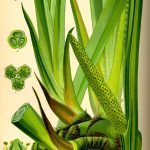 Der (Indische) Kalmus (Acorus calamus) ist eine Pflanzenart aus der Gattung Kalmus (Acorus) innerhalb der Familie Kalmusgewächse (Acoraceae). Die Sumpfpflanze stammt aus Asien, wurde im 16. Jahrhundert in Mitteleuropa eingebürgert und ist auf der gesamten Nordhalbkugel verbreitet. Read more
Der (Indische) Kalmus (Acorus calamus) ist eine Pflanzenart aus der Gattung Kalmus (Acorus) innerhalb der Familie Kalmusgewächse (Acoraceae). Die Sumpfpflanze stammt aus Asien, wurde im 16. Jahrhundert in Mitteleuropa eingebürgert und ist auf der gesamten Nordhalbkugel verbreitet. Read more
Agathis australis
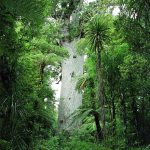 Agathis australis, allgemein bekannt unter dem Maori-Namen Kauri, ist ein Nadelbaum der Araucariaceae der Gattung Agathis, der nördlich von 38 ° S in den nördlichen Bezirken der neuseeländischen Nordinsel vorkommt. Kauri-Wälder gehören zu den ältesten der Welt. Der Baum hat glatte Rinde und kleine schmale Blätter.
Agathis australis, allgemein bekannt unter dem Maori-Namen Kauri, ist ein Nadelbaum der Araucariaceae der Gattung Agathis, der nördlich von 38 ° S in den nördlichen Bezirken der neuseeländischen Nordinsel vorkommt. Kauri-Wälder gehören zu den ältesten der Welt. Der Baum hat glatte Rinde und kleine schmale Blätter.
Read more
Amerikanische Zeder
Die Weihrauchzeder, Kalifornische Weihrauchzeder oder Kalifornische Flusszeder (Calocedrus decurrens) bildet eine der vier Arten der Gattung der Weihrauchzedern (Calocedrus). Kennzeichen dieser Art sind die aus sechs Schuppen aufgebauten, länglichen, einjährigen Zapfen, die Thujen-ähnlichen Zweige und die orangefarbene, längsrissige Borke älterer Bäume.
Read more
Artemisia absinthium (Wermutkraut)
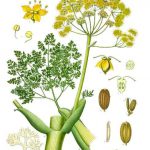 Artemisia absinthium L., Gemeiner Wermut oder auch Wermutkraut (engl. Wormwood, griech. Αρτεμισία το αψίνθιο), hat ihr natürliches Vorkommen in den gemäßigten Regionen Eurasiens sowie in Nordafrika. Obschon die Pflanze auch hierzulande oft anzutreffen ist und sie zu den seit Jahrhunderten in Klostergärten kultivierten Heilkräutern zählt,Read more
Artemisia absinthium L., Gemeiner Wermut oder auch Wermutkraut (engl. Wormwood, griech. Αρτεμισία το αψίνθιο), hat ihr natürliches Vorkommen in den gemäßigten Regionen Eurasiens sowie in Nordafrika. Obschon die Pflanze auch hierzulande oft anzutreffen ist und sie zu den seit Jahrhunderten in Klostergärten kultivierten Heilkräutern zählt,Read more
Aralia racemosa
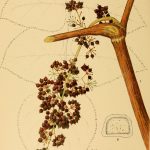 Aralia racemosa ist eine Zierpflanze aus der Familie der in den USA und Kanada beheimateten Araliaceae. Sie trägt die gebräuchlichen Namen American Spikenard, Small Spikenard, Indian Root, Spice Berry, Spignet, Life-of-Man und Petty Morel. Es ist eine etwa 1 bis 2 m hohe krautige Pflanze, die in schattigen Gegenden wächst. Das heimische Verbreitungsgebiet umfasst den größten Teil der östlichen Vereinigten Staaten. Die erste Veröffentlichung von Aralia racemosa erfolgte 1753 durch Carl von Linné. (aus Wikipedia)
Aralia racemosa ist eine Zierpflanze aus der Familie der in den USA und Kanada beheimateten Araliaceae. Sie trägt die gebräuchlichen Namen American Spikenard, Small Spikenard, Indian Root, Spice Berry, Spignet, Life-of-Man und Petty Morel. Es ist eine etwa 1 bis 2 m hohe krautige Pflanze, die in schattigen Gegenden wächst. Das heimische Verbreitungsgebiet umfasst den größten Teil der östlichen Vereinigten Staaten. Die erste Veröffentlichung von Aralia racemosa erfolgte 1753 durch Carl von Linné. (aus Wikipedia)
Artemisia Vulgaris
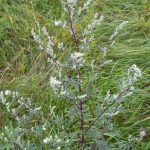 Artemisia Vulgaris (commonly known as mugwort, felon herb, chrysanthemum weed, wild wormwood, Old Uncle Henry, sailor’s tobacco, naughty man, old man or St. John’s plant ) is a tall herbaceous perennial plant growing 1–2 m tall, with a woody root, native to temperate Europe, Asia, northern Africa and Alaska.Read more
Artemisia Vulgaris (commonly known as mugwort, felon herb, chrysanthemum weed, wild wormwood, Old Uncle Henry, sailor’s tobacco, naughty man, old man or St. John’s plant ) is a tall herbaceous perennial plant growing 1–2 m tall, with a woody root, native to temperate Europe, Asia, northern Africa and Alaska.Read more
Succinit (Baltischer Bernstein)
 Bernstein (aus mittelniederdeutsch: Börnesteen, d.h. „Brennstein“) ist ein fossiles Harz, welches von einer ausgestorbenen, bis heute nicht abschließend identifizierten Pflanzenart stammt. Die bei weitem häufigste Bernsteinart ist das Succinit, von dem es im Baltikum nach einer Schätzung noch mehr als 640.000 t geben soll.Read more
Bernstein (aus mittelniederdeutsch: Börnesteen, d.h. „Brennstein“) ist ein fossiles Harz, welches von einer ausgestorbenen, bis heute nicht abschließend identifizierten Pflanzenart stammt. Die bei weitem häufigste Bernsteinart ist das Succinit, von dem es im Baltikum nach einer Schätzung noch mehr als 640.000 t geben soll.Read more
Betula (Birke)
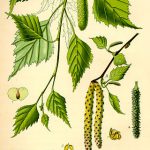 Die Birke (Betula) umfasst eine eigene Pflanzengattung, deren ca. 100 Arten auf der Nordhalbkugel – von Europa über Russland und Asien bis Japan und Nordamerika vorkommen. Birken sind oft Pionierpflanzen und gedeihen sowohl auf trockenen wie nassen Böden, in Heidegebieten, auf Dünen wie auf Moor – sogar auf Häusern und Ruinen. Neben Espe und Kiefer gehörten sie zu den ersten Bäumen, die nach der letzten Eiszeit Wälder bildeten.
Die Birke (Betula) umfasst eine eigene Pflanzengattung, deren ca. 100 Arten auf der Nordhalbkugel – von Europa über Russland und Asien bis Japan und Nordamerika vorkommen. Birken sind oft Pionierpflanzen und gedeihen sowohl auf trockenen wie nassen Böden, in Heidegebieten, auf Dünen wie auf Moor – sogar auf Häusern und Ruinen. Neben Espe und Kiefer gehörten sie zu den ersten Bäumen, die nach der letzten Eiszeit Wälder bildeten.
Boswellia sacra
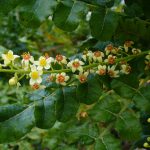 Boswellia sacra (commonly known as frankincense or olibanum-tree) is a tree in the Burseraceae family, from which frankincense, a resinous dried sap, is harvested. It is native to the Arabian Peninsula (Oman, Yemen) , and northeastern Africa (Somalia). Read more
Boswellia sacra (commonly known as frankincense or olibanum-tree) is a tree in the Burseraceae family, from which frankincense, a resinous dried sap, is harvested. It is native to the Arabian Peninsula (Oman, Yemen) , and northeastern Africa (Somalia). Read more
Cedrus deodara
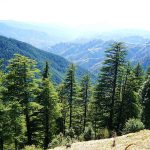 Cedrus deodara (Deodar-Zeder, Himalaya-Zeder) ist eine Zedernart, die im westlichen Himalaya in Ostafghanistan, Nordpakistan und Nordindien, in Tibet und Westnepal in 1.500 bis 3.200 m Höhe vorkommt.
Cedrus deodara (Deodar-Zeder, Himalaya-Zeder) ist eine Zedernart, die im westlichen Himalaya in Ostafghanistan, Nordpakistan und Nordindien, in Tibet und Westnepal in 1.500 bis 3.200 m Höhe vorkommt.
Read more
Cedrus libani (Libanonzeder)
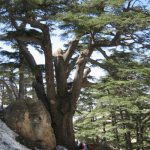 Die Libanon-Zeder (Cedrus libani) wächst vor allem entlang der Mittelmeerküste Süd- und Südwestanatoliens, im Libanon, dessen Wahrzeichen sie ist und auf den Höhenlagen des Dschebel Aansariye in Syrien. Sie ist ein immergrüner Baum, der Wuchshöhen von 30 bis 50 Meter erreicht und über 1.000 Jahre alt werden kann. Die größte und älteste Zeder Deutschlands (gepflanzt ca. 1720, Stammumfang 5,20 Meter) steht in Weinheim.
Die Libanon-Zeder (Cedrus libani) wächst vor allem entlang der Mittelmeerküste Süd- und Südwestanatoliens, im Libanon, dessen Wahrzeichen sie ist und auf den Höhenlagen des Dschebel Aansariye in Syrien. Sie ist ein immergrüner Baum, der Wuchshöhen von 30 bis 50 Meter erreicht und über 1.000 Jahre alt werden kann. Die größte und älteste Zeder Deutschlands (gepflanzt ca. 1720, Stammumfang 5,20 Meter) steht in Weinheim.

 English
English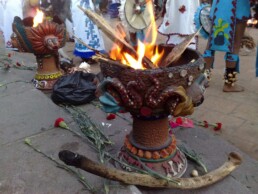
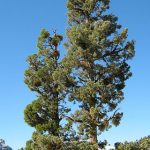
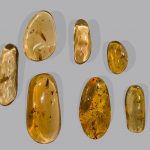 Copal is a name given to tree resin from the copal tree Protium copal (Burseraceae) that is particularly identified with the aromatic resins used by the cultures of pre-Columbian Mesoamerica as ceremonially burned incense and other purposes.
Copal is a name given to tree resin from the copal tree Protium copal (Burseraceae) that is particularly identified with the aromatic resins used by the cultures of pre-Columbian Mesoamerica as ceremonially burned incense and other purposes.